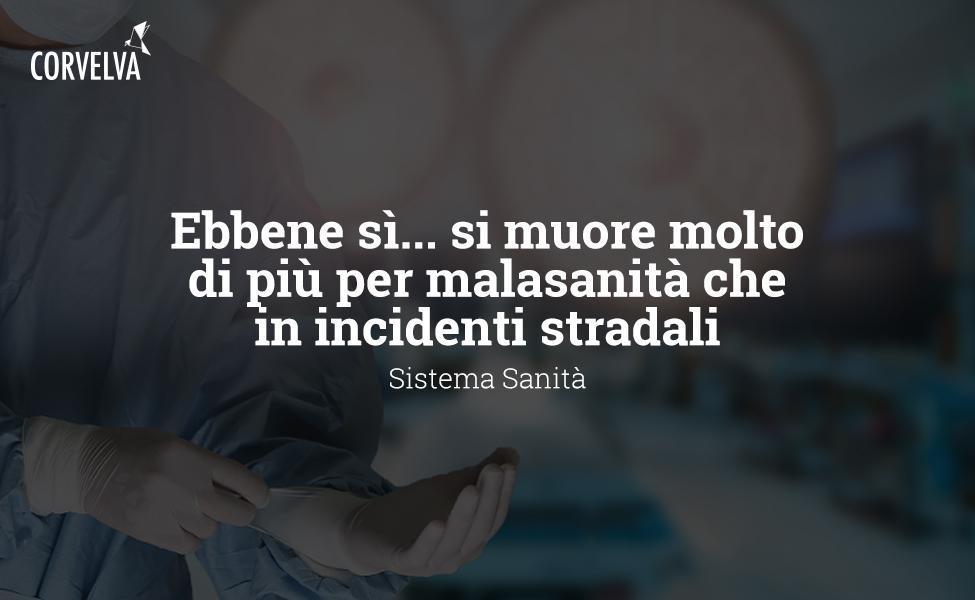45.000 deaths every year from medical malpractice

The data we bring you are slightly dated, but then not so much since we are talking about 2011. "45.000 medical malpractice deaths in Italian hospitals" was the title of the Newsletter fortnightly on bioethical and civil rights issues, issue 46, of 6 December 2013 by Carlo Troilo, Luca Coscioni Association.
The Luca Coscioni Association asked a manager of the same association, as well as professor of Analysis and organization of health systems at the Politecnico di Milano, Prof. Marcello Crivellini, to comment on a previous article that appeared in the "Corriere della Sera" and the response was careful analysis of which we report the entire text. We would like to anticipate one data above all:
Every year in Italy there are just under 500.000 errors due to medical malpractice, including over 45.000 deaths. On average, 4.000 people die from road accidents per year, 1000 from work.
How many deaths from medical malpractice?
The negative effects of health on the health and finances of citizens are due to at least 3 types of behavior:
- behaviors of operators who make mistakes due to professional incapacity or bad corporate management
- behaviors of operators and companies intentionally aimed at drawing economic benefits, even if in contrast with the health (and finances) of users
- behaviors of operators and companies that support the fears of the sick (or presumed such) and favor the economic-social power of operators and companies, while going against the protection of health and professional ethics.
Type 1 includes true clinical-health errors due to lack of competence, superficiality or slovenliness in the management of the treatment process by individual operators or health companies. Examples can be: wrong diagnoses, surgical interventions or administration of drugs wrong or in wrong doses, delays, patient exchanges, etc. ... Paradoxically, they are the most easily preventable.
Type 2 typically includes unnecessary services and therapeutic interventions which are carried out for personal and / or corporate benefit: many operations "suggested" to patients, too many prescriptions for drugs and diagnostic tests (the National Health Service or the patient) not necessary for the health of citizens but useful for the budget of those who prescribe. International studies estimate that around 30-40% of all healthcare is unnecessary. And in the case of interventions on the body, unnecessary interventions are also harmful to the patient, both in terms of health and economically. This mass of useless and harmful health care for the patient (but useful for health professionals and companies) is called "induced health care".
The third type of behavior takes advantage of the fragile conditions of the sick (or of those who fear being so) and their fears, supporting them in attributing diagnostic or therapeutic capabilities to interventions that should not be prescribed but which are prescribed on the "pressure" of patients or to build future alibis; in this way one renounces one's professional duties, consciously feeding illusions and providing an expensive and also useless (therefore potentially harmful) "placebo". It is what doctors usually call "defensive medicine", forgetting to define the first two behaviors as "offensive medicine".
All three of these types of behaviors are present and widespread in healthcare, with enormous dimensions and effects. Therefore the distinction between "medical malpractice" and health is in some respects misleading. The distinction that should always be kept in mind is between health and health, measuring and evaluating health only and exclusively on the basis of its real (and scientifically proven) effects on health.
Even the debate on funding or cuts should only be based on this distinction. In other words, the confusion between health and health pushes operators, health companies, internal interests or those bordering on health (in Italy 9,2% of GDP, over 140 billion euros a year is spent on health) to ask for more money for health care, boasting that they will automatically turn into more health for citizens. This is not the case: all the comparative data on health and health of industrialized countries belie this fable for the use and consumption of health care and its internal needs.
Going back to what is called "medical malpractice" by the media it is good to know that the striking cases reported periodically are only the tip of the iceberg of what really occurs.
Since the 90s many international studies have quantified errors in health care, and in particular those in the hospital. They measured that the number of "adverse events" (errors that cause harm to patients) is between 4 and 12% of hospitalizations and that at least 4% of these adverse events result in the death of the patient.
Only recently (2011) has a similar serious research been carried out in Italy, the conclusions of which have been:
- 5,2% of the hospitalized suffer an adverse event,
- 9,5% of them lead to the patient's death.
These conclusions compel to affirm that the errors on the hospitalized are in Italy just under 500 thousand a year and that the deaths due to them are over 45 thousand a year. Traffic fatalities are around 4, those at work around XNUMX a year.
There has been no television broadcast on these frightening data and the only articles are confined to the "technical" pages of a few newspapers.
Certainly the article by Ravizza and Santucci must be considered positively; it deals with an important but marginal aspect with respect to the phenomena seen, their nature and size.
Source:

